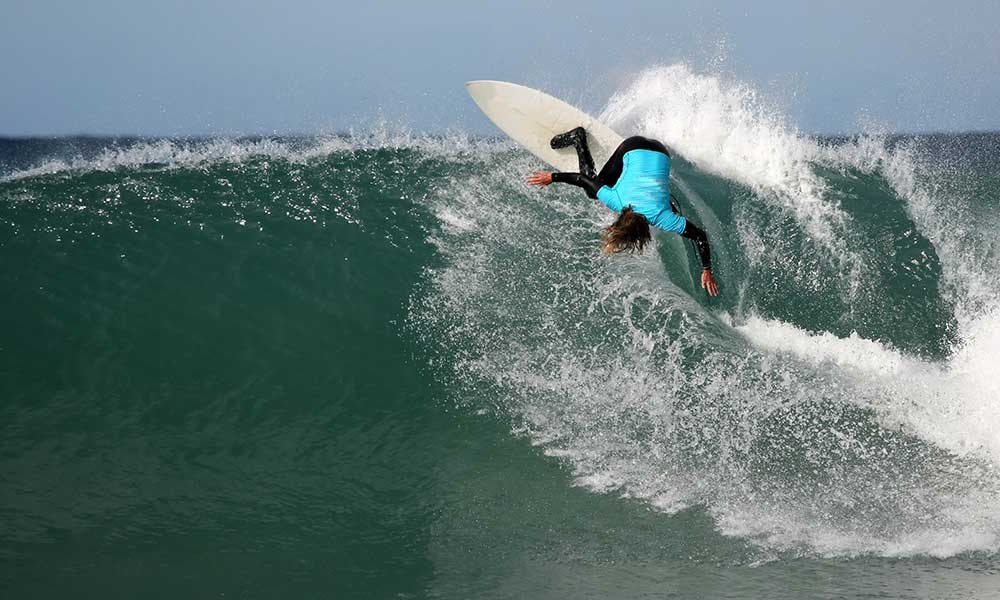A surf fin impacts a surfer’s performance in multiple ways. Fins:
- Provides more acceleration and overall speed
- Increase the surfboard’s ability to grip in the water
- Allows for more hold during turns
- Reduces backend sliding and decreases the chance of a wipeout
They do this by creating horizontal lift, which is where the backend stability comes from and why the surfboard can remain in control during sharp turns. They also create drag, which impacts the speed of the surfboard.
Choosing Your Surf Fin Set Up Configuration
Once you know the size, it’s time to choose the right configuration.
Check the bottom of your surfboard for between 1 and 5 spaces to indicate whether it’s a single fin, twin fin, thruster or tri-fin, or quad set up. If there are 5 spaces, it means you have a little more freedom to mix and match.
Single Fin Set Up
Common on longboards, the single fin setup is also the most traditional.
Single fins tend to be larger than the fins used on other setups and provide the sort of stability and control that beginners need. At the same time, however, single fins have very limited movement and are not the best for maneuverability.
Most longboard fin boxes are long, so you can adjust where the fin is attached, bringing it forward to provide more ease when turning and moving it back to deliver more control.
Twin Fin Fin Set Up
Twin fins are often fitted to shortboards with a view to increasing speed and making the boards maneuverable, fast, and fun. They are not ideally suited for riding big waves but are great for most other types of surf up a little more than head high
3 Fin / Thruster Fin Set Up
Thruster setups are very common these days and can be seen on all shapes and sizes of surfboards including shortboards, longboard and fun shapes. The fins are positioned in a “V” shape with the trailing fin closer to the tail of the surfboard and 2 fins a few inches up from the trailing fin towards the nose of the surfboard.
A thruster setup can be configured as a single fin or twin fins, and when left as a tri-fin it provides a great deal of stability, speed, and control.
Quad Fin Set Up
Quad fins deliver high speeds and rapid acceleration in smaller surf and can also generate high speed while turning. There are two fins on either side of the board, and these are often angled slightly inward.
Other Surf Fin Set Ups & Configurations
The 2+1 setup: It is quite common and has its uses for longboard and fun shape surfers.
It contains three fins in the same positions as the thruster. The difference is that the back fin is much larger, like a single fin set up, and this provides a couple of configuration options that make the 2+1 ideal for beginners.
As noted above, there is also a 5-fin configuration, although this is not intended to be ridden with all 5 fins and is simply there to create more possible configurations.
Diamond Quad: Four fins designed in a way that is said to make turning easier in Longboards. It was conceived by John Coby and was first tested in 2011.
Bonzer: A three or five fin setup developed in the 1970s. Bonzer was created by the Campbell brothers in the 1970s and was designed to tackle high waves near their home in California.
Tunnel Fun: A tunnel-shaped fin that was first used in the 1960s and continues to be used by modern shapers, often in the creation of Longboards.
What Size Surf Fins Do I Need?
When choosing the right surf fins for you, start with your weight:
- Fin Size Grom = Under 100 lbs.
- Fin Size XS = Under 120 lbs.
- Fin Size S = 105 to 155 lbs.
- Fin Size M = 145 to 195 lbs.
- Fin Size L = 165+ lbs.
- Fin Size XL = 190+ lbs.
If your weight is in one of the overlapping groups, you can choose from either of the two sizes, focusing instead on the material of the fin or the quality of the surfboard.
What Are The Best Fins For A Beginner Surfer?
As a beginner, you don’t really need to concern yourself with whether or not a surf fin is too big or too small, nor do you need to worry about whether you have one, two, or five fins.
Just buy a surfboard that is right for your skill level and your weight and you’ll be good to go.
It’s certainly something that more advances surfers should consider, but as a beginner, just stick with the basics.







